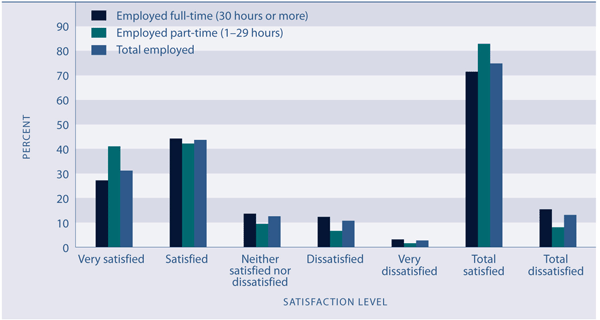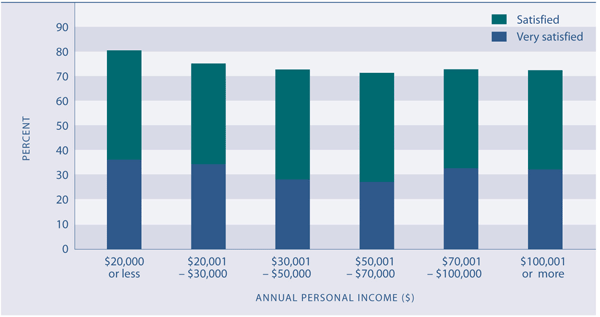Satisfaction with work-life balance
Definition
The proportion of employed people who are "satisfied" or "very satisfied" with their work-life balance, as reported in the Quality of Life Survey 2006.
Relevance
It is important that people find a balance between paid work and other aspects of their lives. When this balance is not found, people may suffer from stress or anxiety. Long working hours or non-standard working hours (eg night shifts) may compromise work-life balance.
Current level
Results from the Quality of Life Survey 2006 show most employed New Zealanders (75 percent) are satisfied or very satisfied with their work-life balance. People in part-time employment (83 percent) are more likely to be satisfied or very satisfied with their work-life balance than people in full-time employment (71 percent).
Figure PW5.1 Satisfaction with work-life balance, by employment status, 2006

Source: Quality of Life Survey 2006
Age differences
Those least likely to be satisfied with their work-life balance in 2006 were employed people aged 25–49 years (71 percent). Those aged 65 years and over (84 percent) were the most satisfied age group.
Sex differences
Employed females (74 percent) have similar rates of satisfaction with work-life balance to employed males (76 percent). Among full-time workers, however, males (74 percent) are more likely to be satisfied or very satisfied with their work-life balance than females (67 percent). Work-life balance satisfaction rates are highest for both male and female part-time workers (both 83 percent).
Ethnic differences
Employed people in the different ethnic groups have similar rates of work-life balance satisfaction. For employed Pacific peoples the rate was 76 percent in 2006, for Europeans 75 percent and the Asian and Other ethnic groups both had worklife balance satisfaction rates of 74 percent. Employed Māori had the lowest rate of satisfaction with work-life balance (71 percent).
Figure PW5.2 Satisfaction with work-life balance, employed people, by ethnic group, 2006

Source: Quality of Life Survey 2006
Socio-economic differences
Employed New Zealanders whose personal incomes are $20,000 or less are the most likely to be satisfied overall with their balance of work and life (80 percent). This group includes many women who work part-time.
Figure PW5.3 Satisfaction with work-life balance, employed people, by personal income, 2006

Source: Quality of Life Survey 2006
Regional differences
Satisfaction with work-life balance among employed people varies across cities. Those people with the highest levels of satisfaction live in Porirua and Auckland (both 77 percent). Manukau City and North Shore recorded the lowest levels of satisfaction (both 69 percent). |



